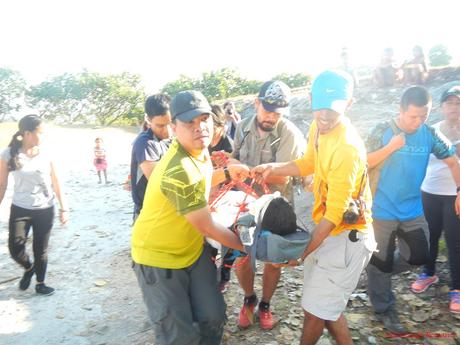
You are happily trekking with your team deep inside a jungle-covered mountain. Suddenly, you hear a horrible scream! One of your team mates has slipped and fallen into a deep ravine. He lies in a heap, and you can see blood soaking his trekking pants. He seems to be drifting in and out of consciousness. With the exception of your team, there’s no help available, and civilization is many miles away. What should you do?
Knowing what to do in emergencies like the scenario we just described is absolutely crucial in the world of outdoor adventure. You always have to keep in mind that Mother Nature, even if she is beautiful, can indifferent and cruel. Proper medical assistance can unavailable or very far away. Rescuers may take some time to reach your team. Thus, your knowledge of wilderness first-aid and rescue techniques can be the key to your or your team member’s survival.
Outpax, our outdoor adventure partner, knows the importance of knowing how to treat injuries and ailments in the wild. Thus, with the cooperation of Base Camp Emergency Response Team, Camp Red, and the Philippine Independence Bushcraft Camp, they conducted a special wilderness first-aid and rescue workshop for outdoor enthusiasts.
At the appointed time, we had a short briefing and introduction of participants in Banawa’s Celestial Gardens. We were quite happy upon seeing several participants bringing family members along. There were two mother-and-son teams as well as a duo of sisters.
We are strong advocates of bringing family members to experience outdoor activities. They will learn to work as a team, appreciate nature, engage in exciting adventures, and establish strong bonds with each other. Based on our experience, an outdoor-oriented family is a happy one.

After the briefing, we headed to our outdoor “classroom.” Supposedly, Outpax planned to hold the workshop in the depths of the Buhisan watershed to simulate a wilderness environment. However, they realized hiking there would shave off a few precious hours off the actual workshop schedule. So they decided to hold the workshop in a much nearer venue about 15 minutes from the gate of Celestial Garden.
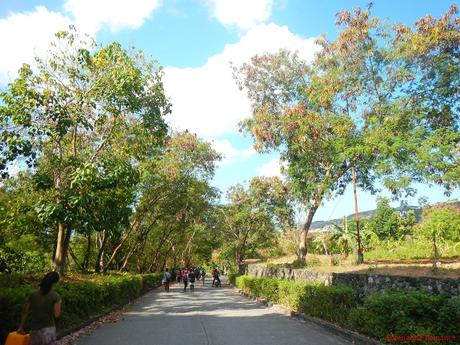
Now, that is truly a celestial garden, isn’t it? The short hike afforded us stunning views of the metropolis and the surrounding areas.
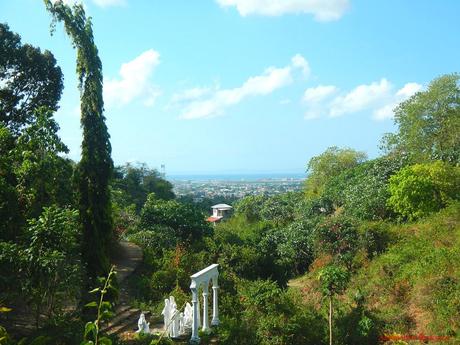
After 15 minutes, we arrived at our venue, a cool trellis with a thick network of bougainvillea vines as a roof. We had uninterrupted views of the hills and mountains of Cebu’s spine, and a constant airy breeze kept us comfortably cool despite the searing morning.
Wasting no time, we began our wilderness first aid workshop. We initially discussed about the importance of knowledge in first aid, preparing for adventures, best safety practices, and first-aid kit creation.
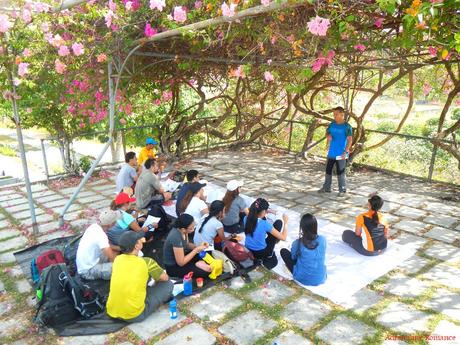
Mr. Christopher Ngosiok of Camp Red, the Philippine’s premier bushcrafting guild, handled the workshop. He is a registered nurse, an emergency responder, and an active member of Camp Red. He is also a 5th Civil Military Affairs Group (CMAG) AFP Reserve. Needless to say, with all his qualifications, he is definitely the right man for this workshop.
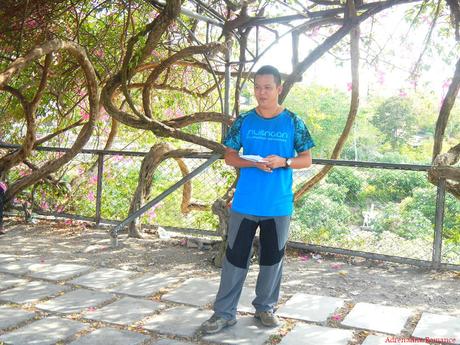
Included in our workshop is this easy-to-use module that serves as a handy first-aid guide that we can bring anywhere. Compiled by Christopher, the module is customized to fit wilderness conditions and common emergencies in the Philippines. In other words, the module contains situations, remedies, and advice that are practical.
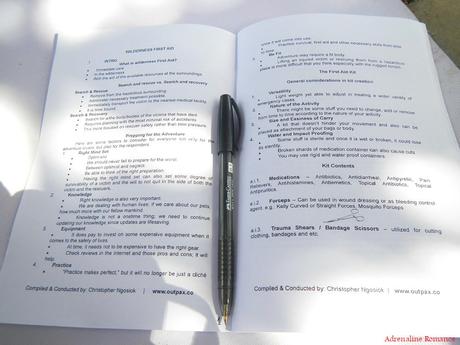
CPR, or cardio-pulmonary resuscitation, is a life-saving procedure of restoring respiration and blood circulation in a non-responsive victim. Christopher showed us the proper way, including positioning ourselves in relation to the victim, on how to do CPR. CPR should be administered within 6 minutes after the blood flow ceases.
Dan, one of our coolest adventuring buddies, volunteered to be the “victim” in all demonstrations. He is a certified Base Camp Emergency Rescue Team (BCERT) first-aider and emergency responder.
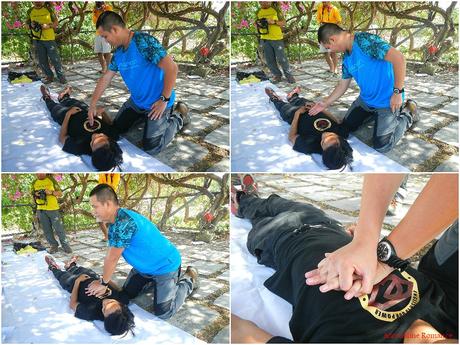
He also showed us how to provide artificial respiration to victims who are unconscious and not breathing. Do not provide artificial respiration to a breathing victim as it can be injurious or even fatal.

While trekking down a beautiful mountain trail, you encounter an injured hiker on his back. He seems to be in great pain, and his body is twisted in an unnatural position. Did he sustain broken bones? Is there internal bleeding? Should you move him right away knowing that the slightest movement may aggravate the injury?
Before doing anything, you should first assess the body for injuries. Christopher demonstrated to us how to do proper emergency head-to-toe assessment without changing the position of the victim. Dan’s body position in the photos below is deliberate.
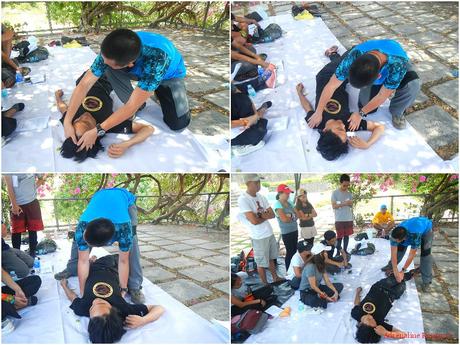
Choking is a common hazard not just in the outdoors (you greedily eat the adobo in your packed lunch) but in urban places such as restaurants and fast-food joints. Don’t laugh but a lump of unchewed food can obstruct one’s air passageway. If the passageway is not cleared, the obstruction becomes fatal.
To get that chunk out, one needs to use the Heimlich maneuver, or abdominal thrust. Properly done, the maneuver exerts pressure on the diaphragm and compresses the lungs, hopefully expelling the lodged object. Our workshop master demonstrated to us on how to do the Heimlich maneuver properly.
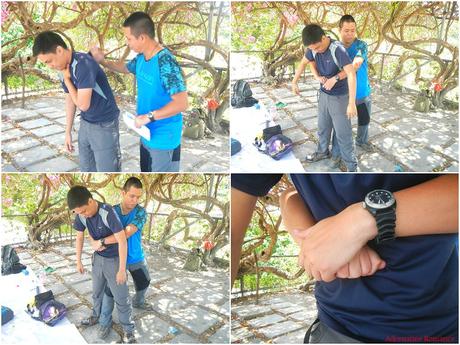
We discussed about common ailments in the outdoors such as fainting, hypoglycemia, cramps, dehydration, asthma attacks, and how to treat them. When we covered half of the 40-page module, we took a break to eat a picnic-style lunch.
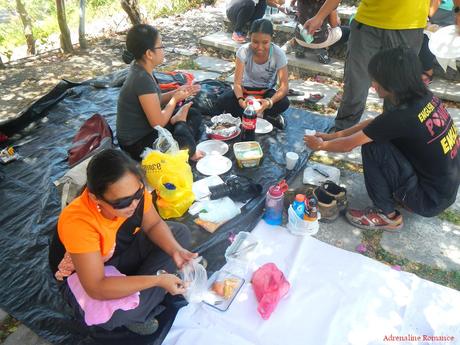
After a short after-meal break, we resumed the wilderness first-aid workshop and identified common medicinal plants in the country. It was quite a surprising revelation knowing that the humble fruits, leaves, roots, and barks of common plants such as garlic, guava, horseradish, and more have effective and powerful curative effects.

How do you treat a team member stricken with seizures and epilepsy? Christopher showed us the way to steady the patient’s head and to roll him over to the side. This position is important so that the drool, which accumulates to a significant amount of froth on the mouth, drains effectively. Without draining, the patient might choke on his own saliva.
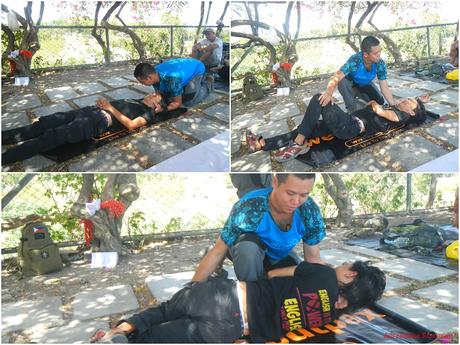
Next, we were shown the many various ways of bandaging the head. The style of bandaging depends on the nature of the head or face injury.
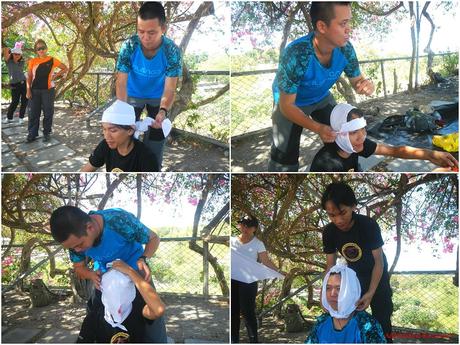
The “donut” is a little bit more complex, requiring the use of two cravats (strips made of folded triangular bandages). The donut bandage is useful for dressing up wounds with impaled objects sticking out.
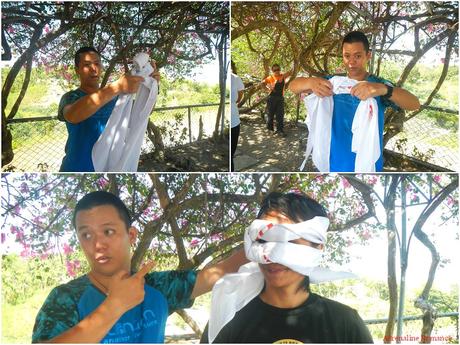
The workshop comes with actual practice sessions. All participants tried the various bandage techniques they have learned on their partners.
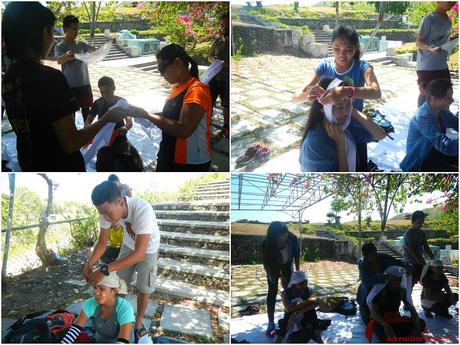
We also bandaged simulated serious leg and thigh wounds.

A large wound or burn to the torso must also be carefully bandaged to protect it from infection. Our workshop master showed us how, and we simulated it on our partners.
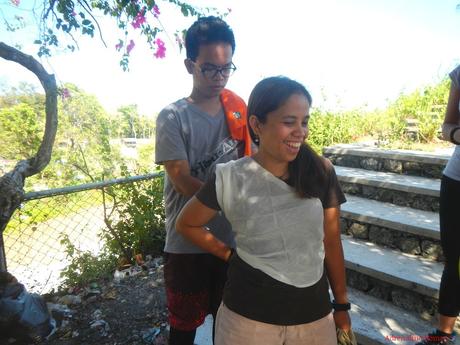
“Here’s how to bandage injured, burned, and wounded shoulders,” Christopher demonstrated. He used two triangular bandages to create a shoulder-armpit cravat.
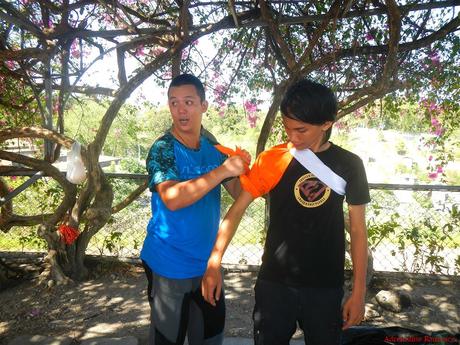
Sprained, broken, and dislocated arms are common injuries in the wilderness. Christopher taught us how to make binders and arm slings to support injured arms.
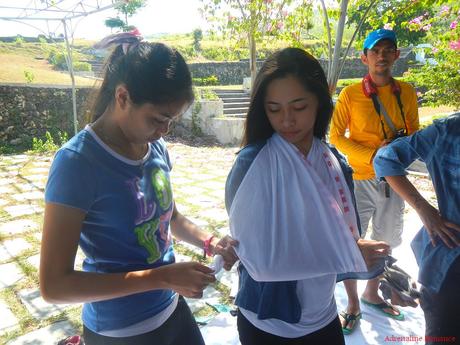
For first timers like us, the process of fashioning bandages, slings, and binders were a little bit complex. So, we had to consult with patterns shown in our module. Don’t worry, with practice, we will be able to do this like the back of our hands.
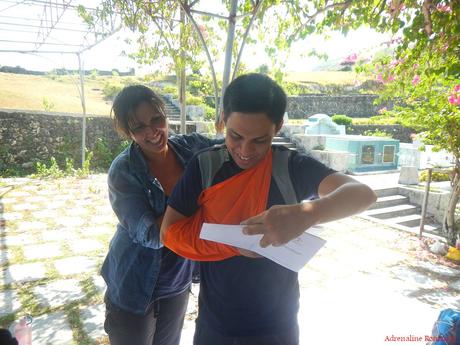
Injuries to the hand and foot can be bandaged quickly and easily.

Christopher also taught us how to create splints from branches, twigs, and other readily available materials. Splints are useful for stabilizing dislocations and limbs with broken bones.

Getting injured people off the danger zone and bringing them towards medical help is of primary importance in an emergency in the outdoors. Injured people may be incapable of bringing themselves out of the wilderness, so Christopher shared various one-man carry techniques so team members can assist in bringing the victim to safety.
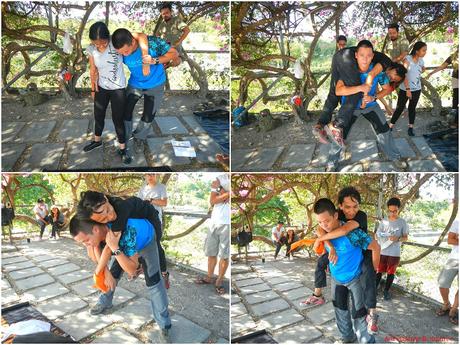
Transporting a victim with the help of multiple individuals is even better and safer.
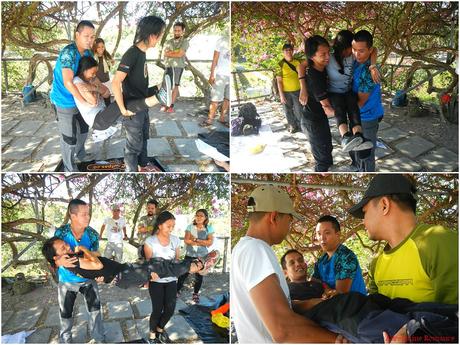
There are situations when carrying an injured person is not feasible. The only way to do that is to drag him. Christopher demonstrated several ways of dragging a person without causing back injury to the rescuer.
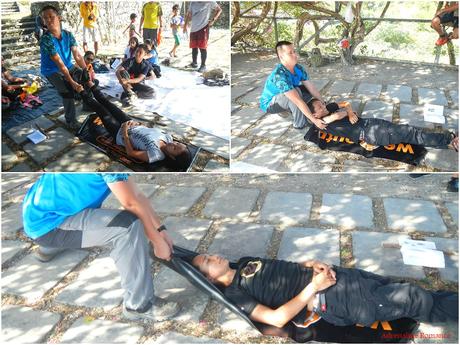
Our workshop master also showed us how to make an emergency, weight-bearing harness out of webbing. This is an important skill to master, especially if one needs to descend or climb a cliff, cross a raging river, suspend himself on a ravine, and more.
Safety organizations all over the world recommends the use of a real rated harness. Thus, improvising a harness should only be used as a last resort.
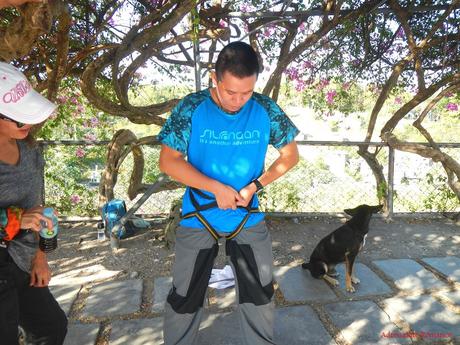
A full-body harness is sometimes required to safely move a victim off a mountain or transport him to safety. Since we don’t normally bring full-body harnesses, Christopher showed us how to improvise a body harness using a rope.
As mentioned before, improvising a harness should only be used as a last resort.
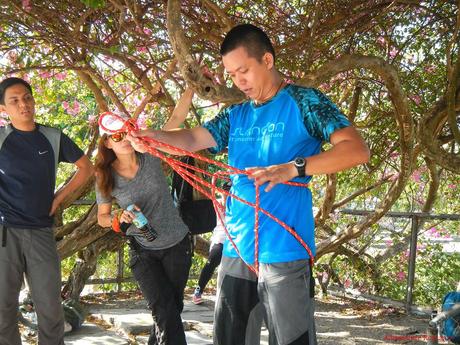
Sometimes, a litter is needed to safely transport a person out of the wild. But we don’t normally carry litters when we go out adventuring. Thankfully, Christopher showed us how to improvise a daisy-chain litter using items we normally carry such as ropes, earth pads, carabiners, and even water bottles. We didn’t even know that a backpack can be made into a headrest, with its waist belt as an improvised strap to stabilize the head.
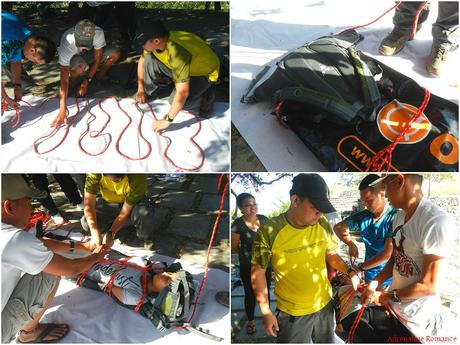
A Simulation
Sometime during a short break, Christopher, who went out for a little while, came running back to our venue. His face was haggard, sweaty, and panicked. He revealed that one of our team members had an accident. He fell into a ravine and broke his leg.
Right away, our team ran to the scene of the accident. The victim was in agony and was about to lose consciousness. He has an open fracture on his leg, which makes the situation more complicated. An open fracture happens when the bone protrudes out of skin through a wound. This is quite serious as the open wound is prone to infection.
A personal note: We have to admit that seeing an injured person at the most unexpected of moments truly shocked us! It took us a few minutes to gather our wits and senses, and recover from confusion and panic. Those precious minutes can be the difference between life and death. It’s not easy, but we need to be calm when confronted with emergency situations. Only when we are calm and composed can we think properly.

After the initial shock wore off, the team sprung into action. People immediately looked for splints and opened their first-aid kits while others assessed the injury and created splints.
At one time, the victim lost consciousness and respiratory activity. We had to administer CPR so we could restart blood circulation and respiration.
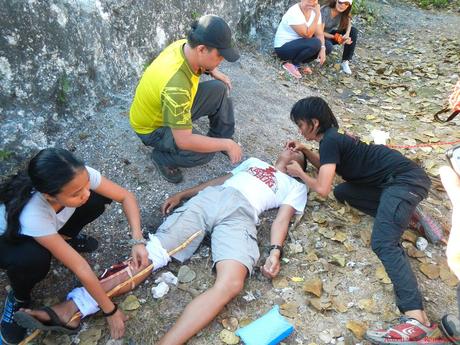
While half of the team tended to the victim, the others prepared to create a daisy-chain litter using a rope.
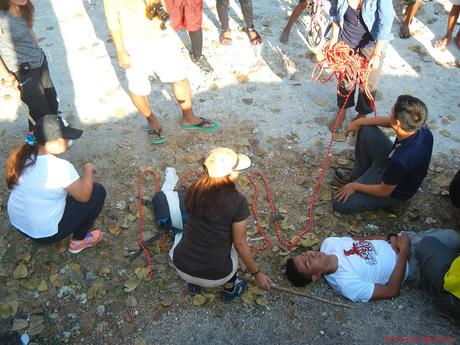
With the victim conscious and the fracture stabilized, it was time to secure him to the litter and transport him. One of the problems we encountered this time was that our litter was too short, and the rope was bundled in a confusing coil that took ages to unravel. That was part of the situation, and it can really happen in the wild.
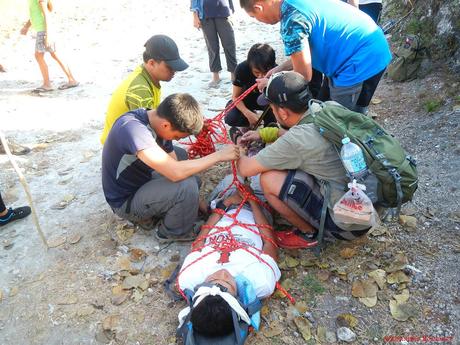
One, two, three, lift! We lifted the victim to an extraction point about 50 yards from the accident site. Once we reached the extraction point and lowered the victim, Christopher declared, “Mission accomplished!” Good job, everyone!
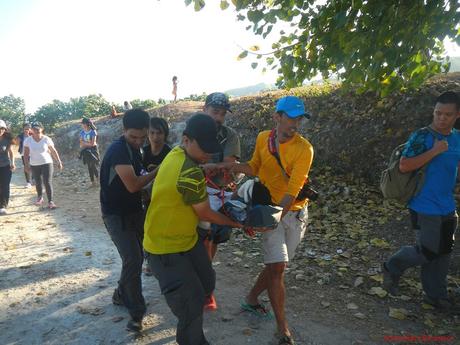
Of course, the accident was just a simulation, but it was the closest to the real thing. Everyone’s heart is pounding, and panic and doubt—and adrenaline—set in. Thank goodness Christopher trained us on how to handle these situations. According to his chronometer, the entire rescue took 17 minutes from the arrival of the team to the successful transportation of the victim to the extraction point. That is still way too long, but considering that this is our first time to handle such a simulated emergency, it was actually pretty good.
As the sun worked its way down the horizon, we had a short debriefing where every member shared what they learned during the workshop.
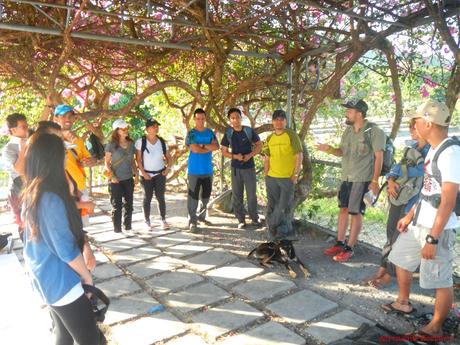
The Wilderness First Aid Workshop was a remarkable success. The knowledge that was imparted upon us will help us become stewards of life. It helps us become more confident of ourselves for not just being responsible outdoorsmen but for being compassionate lifesavers.
Special Thanks
We would like to express our gratitude to Mr. Christopher Ngosiok for sharing his vast knowledge of wilderness first-aid. Thank you to EMT, first responder, and outdoor buddy Joseph Inosante (guy in green) of BCERT for augmenting the workshop with his knowledge as well.
We would also like to thank Outpax founder Eric Monsanto for inviting us to this information-filled event, and BCERT first responder Dan Leo Plaza for volunteering to be the “victim” in various scenarios. Sorry, Dan, no one brought a medical-training manikin. Hehehe!

Thank you too to all the participants of Outpax’s Wilderness. You made the event fun and successful. We hope to see you in more outdoor adventures. But most importantly, we have full confidence in them knowing that whenever we are with them, they know what to do when the unthinkable happens.
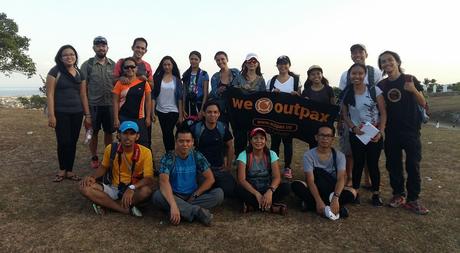
(Photo credit: Josephine Molo Tamayo)
We highly recommend all outdoorsmen to take this workshop to make your outdoor adventures and sojourns safer.
This event is powered and organized by Outpax, Camp Red, PBIC, and BCERT. To organize and join events, click here.
For more information and details on Outpax events, get in touch with Eric Tuñacao (OutPax) at 0922-7721552. You can also send him a personal message on Facebook.
Check out other exciting events and communicate with other outdoorspeople by visiting the Outpax Facebook Page.

